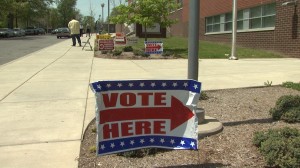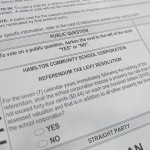Your Guide To School Referenda On The May 2016 Ballot

Many schools started turning to these referendum questions after property tax caps went into place in 2008. (photo credit: Jashin Lin/WTIU News)
As the May 3 Indiana primary approaches, ten school districts across the state are asking voters to raise taxes to fund school projects.
In November 2008, Indiana’s public school districts began posing more and more school funding questions to their communities on the ballot – should taxes be raised to fund a certain construction project or boost the district’s general fund?
If a referendum passes, the property taxes increase by a specified amount for a specific period of time. They were rare before the property tax cap. Since November 2008, there have been 128.
It’s a part of the ballot that has significant impact on a local community, but voters often arrive at the polls with little information about their community’s referendum question and why it is there.
There are ten referendum on the May 3 primary ballots. They span the entire state, big and small school districts and fund both general funds and construction projects. Over the next week, we’re going to dig into the ballot questions around the state to bring voters more information about each of them. Here are the ten school districts asking their communities for tax increases:
- Ft. Wayne Community Schools
- New Prairie United School Corporation
- Argos Community Schools
- Brown County Schools
- Hamilton Southeastern Schools
- MSD of Southwest Allen County
- Noblesville Schools
- School Town of Speedway
- Southern Wells Community Schools
- Wabash City Schools
Referenda Trends Since 2008
School referendum questions became a common ballot measure in Indiana back in 2008, after the legislature voted to enact property tax caps. The caps were written into the state constitution, and the amendment says the government may not collect taxes equaling more than one percent of an owner occupied residence, two percent for other residential properties and three percent for all other properties.
But school districts used to depend on property tax money. Without it, many turned to referenda to supplement.
Larry DeBoer, professor of agricultural economics at Purdue, studies local government budgets and has followed the trends with Indiana’s referenda since 2008. He says typically, school districts that pose their questions during the May primary see a higher success rate.
“About two thirds of all the referenda passed in May have passed, but only 36 percent of those tried in November actually pass.”
His reason for the trend?
“What I think happens is – in a May election the folks who show up are motivated,” DeBoer says. “There’s often not much else happening in a May primary election to attract voters. But in an ordinary May election a school referendum may be the most important thing on the ballot.”
This isn’t an ordinary May primary
As we all know, more voters than usual will likely vote May 3 because of the high stakes presidential primary. Because of this, DeBoer says a more diverse group of voters will likely go to the polls.
Typically during May primaries, the ‘motivated’ voters, as DeBoer calls them, are people who feel strongly for or against the referendum question and show up to vote. But this year, he predicts the voter turnout will likely mirror the group that turns out for general elections.
“These might be people who don’t realize there are referenda on the ballot,” he says. “It may mean that this May we have an election that’s more like November elections than they ordinarily might be.”
Which means more voters who haven’t heard of the referendum. DeBeoer says these people often don’t have kids in the school system and can be more wary of raising taxes for something they don’t see a direct impact on.
Next week, StateImpact will look at all ten questions and explain what each measure is asking local voters.
